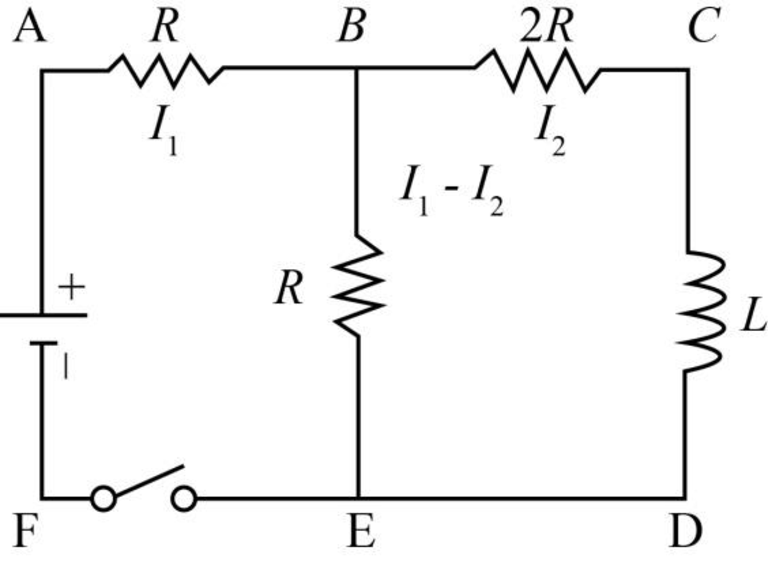
(a)
The current in the inductor as a function of time.
(a)
Answer to Problem 26P
The current in the inductor as a function of time is
Explanation of Solution
Write the expression based on junction rule.
Here,
Write the expression to obtain the loop rule.
Here,
Write the expression to obtain the current in the circuit.
Here, current in the circuit is
The current flow in the circuit is as shown in the figure below.

Figure-(1)
Write the expression to obtain the voltage the loop
Here,
Write the expression to obtain the loop
Here,
Re-write the above equation.
Substitute
Further solve the above equation.
The general solution of the linear differential equation.
Here,
Substitute
Substitute
Substitute
Conclusion:
Substitute
Therefore, the current in the inductor as a function of time is
(b)
The current in the switch as a function of time.
(b)
Answer to Problem 26P
The current in the switch as a function of time is
Explanation of Solution
Consider equation (II) to obtain the current in the switch as a function of time.
Substitute
Further substitute
Conclusion:
Substitute
Therefore, the current in the switch as a function of time is
Want to see more full solutions like this?
Chapter 32 Solutions
Physics For Scientists And Engineers With Modern Physics, 9th Edition, The Ohio State University
- A 5000-pF capacitor is charged to 100 V and then quickly connected to an 80-mH inductor. Determine (a) the maximum energy stored in the magnetic field of the inductor, (b) the peak value of the current, and (c) the frequency of oscillation of the circuit.arrow_forwardConsider the circuit in Figure P32.18, taking = 6.00 V, L = 8.00 mH, and R = 4.00 . (a) What is the inductive time constant of the circuit? (b) Calculate the current in the circuit 250 s after the switch is closed. (c) What is the value of the final steady-state current? (d) After what time interval does the current reach 80.0% of its maximum value?arrow_forwardIn an oscillating LC circuit the maximum charge on the capacitor is 2.0 × 10-6 C and the maximum current through the inductor is 8.0 mA. (a) What is the period of the oscillations? (b) How much time elapses between an instant when the capacitor is uncharged and the next instant when it is fully charged?arrow_forward
 Principles of Physics: A Calculus-Based TextPhysicsISBN:9781133104261Author:Raymond A. Serway, John W. JewettPublisher:Cengage Learning
Principles of Physics: A Calculus-Based TextPhysicsISBN:9781133104261Author:Raymond A. Serway, John W. JewettPublisher:Cengage Learning Physics for Scientists and EngineersPhysicsISBN:9781337553278Author:Raymond A. Serway, John W. JewettPublisher:Cengage Learning
Physics for Scientists and EngineersPhysicsISBN:9781337553278Author:Raymond A. Serway, John W. JewettPublisher:Cengage Learning Physics for Scientists and Engineers with Modern ...PhysicsISBN:9781337553292Author:Raymond A. Serway, John W. JewettPublisher:Cengage Learning
Physics for Scientists and Engineers with Modern ...PhysicsISBN:9781337553292Author:Raymond A. Serway, John W. JewettPublisher:Cengage Learning Physics for Scientists and Engineers, Technology ...PhysicsISBN:9781305116399Author:Raymond A. Serway, John W. JewettPublisher:Cengage Learning
Physics for Scientists and Engineers, Technology ...PhysicsISBN:9781305116399Author:Raymond A. Serway, John W. JewettPublisher:Cengage Learning Physics for Scientists and Engineers: Foundations...PhysicsISBN:9781133939146Author:Katz, Debora M.Publisher:Cengage Learning
Physics for Scientists and Engineers: Foundations...PhysicsISBN:9781133939146Author:Katz, Debora M.Publisher:Cengage Learning





